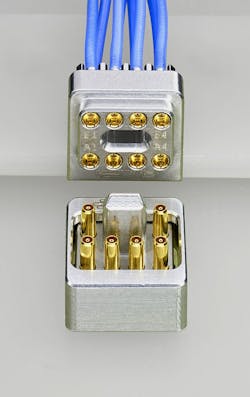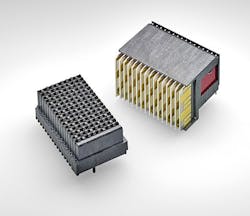TE Connectivity focuses on speed, density in embedded computing interconnects
AUSTIN, Texas. OpenVPX is rapidly evolving as a standard architecture for next-generation critical embedded computing, says Mike Walmsley, global product manager at TE Connectivity, maker of connectivity and sensors, in Harrisburg, Pennsylvania. “As a result of this drive toward standardization, there is an evolution toward smaller packaging, increased functionality, and faster processing.”
TE Connectivity’s Walmsley presented the company’s new MULTIGIG RT 3 connectors, NanoRF, and High Density Optical modules at VITA’s Embedded Tech Trends (ETT) in Austin, Texas. TE’s latest interconnect products for rugged embedded computing systems include offerings built to meet OpenVPX standards; this year, the company also plans to release “several breakthrough products that support this evolution.”
TE’s MULTIGIG RT 3 high-speed backplane connector supports channels of 16Gb/s to support PCIe Gen 4 protocol and 25Gb/s for Ethernet 100GBASE-KR4. It is intermateable with legacy systems using MULTIGIG RT 2 or 2-R connectors. The MULTIGIG RT 3 connector features enhanced PCB wafer and contact designs and uses an optimized PCB footprint for higher data rates.
TE’s NanoRF Module doubles the density of current VITA 67 standards using SMPM interfaces. Designed specifically for rugged applications, it uses microminiature high-frequency contacts that are pre-aligned before mating and a floating plate to assure no stubbing and to minimize wear.
TE’s High Density Optical Module is based on VITA 66, and provides double the fiber density compared to VITA 66.4. By bringing two MT ferrules into a half module, it supports 24 or 48 fibers in a VPX half module space.
These new products introduced by TE into the VITA industry in 2018 will help enable significant gains in bandwidth and functionality for tomorrow’s embedded computing systems, Walmsley says.
“TE is actively working alongside technology leaders within the embedded computing industry to develop interconnects that break barriers for tomorrow’s systems,” Walmsley adds. “These three interconnect solutions will enable increases in processing capability within smaller systems packaging.”
TE partners with companies like Curtiss-Wright to integrate these advanced embedded computing connectors into today’s defense applications.
“Curtiss-Wright Defense Solutions is working closely with key partners like TE to enable the next generation of VPX using fabrics like PCIe Gen 4.0 and 100G-KR4 Ethernet,” says Lynn Bamford, senior vice president and general manager, defense solutions division at Curtiss-Wright. “The new MULTIGIG RT 3 connector delivers a significant leap in performance, enabling VPX to reliably transmit the ever-higher signaling speeds used by these protocols. Combining the RT 3 with our advanced high-speed module and system design rules will enable VPX system designers to deploy previously unreachable levels of performance in support of new applications and capabilities.”
TE offers a suite of products for OpenVPX architecture including MULTIGIG RT high-speed backplane connectors (VITA 46), RF modules (VITA 67), optical modules (VITA 66), Mezalok connectors for XMC 2.0 mezzanine cards (VITA 61), and MULTIBEAM XLE for power supplies (VITA 62).
TE Connectivity Ltd. is a $13 billion global technology and manufacturing company creating a safer, sustainable, productive, and connected future. For more than 75 years, our connectivity and sensor solutions, proven in the harshest environments, have enabled advancements in transportation, industrial applications, medical technology, energy, data communications, and the home.
Curtiss-Wright Corp. (NYSE:CW) delivers highly engineered, critical function products and services to the commercial, industrial, defense, and energy markets. Building on the heritage of Glenn Curtiss and the Wright brothers, Curtiss-Wright has a long tradition of providing reliable solutions through trusted customer relationships.
Continue the embedded computing discussion
This discussion was one of many high-level, technical presentations at VITA’s Embedded Tech Trends (ETT), an annual conference on embedded computing technologies and trends, held this week in Austin, Texas. For more from ETT, visit http://www.intelligent-aerospace.com/search.html?q=Embedded+Tech+Trends
The go-to resource for Intelligent Aerospace technology news & information:
Covering key topics
Across all market segments
Subscribe to the free Intelligent Inbox e-newsletter: http://www.intelligent-aerospace.com/subscribe.html.
Connect on social media:
Keep pace with aerospace innovation and opportunities via your favorite social media channels. Connect with Intelligent Aerospace on Twitter (@IntelligentAero), LinkedIn,Google+, and Instagram.




